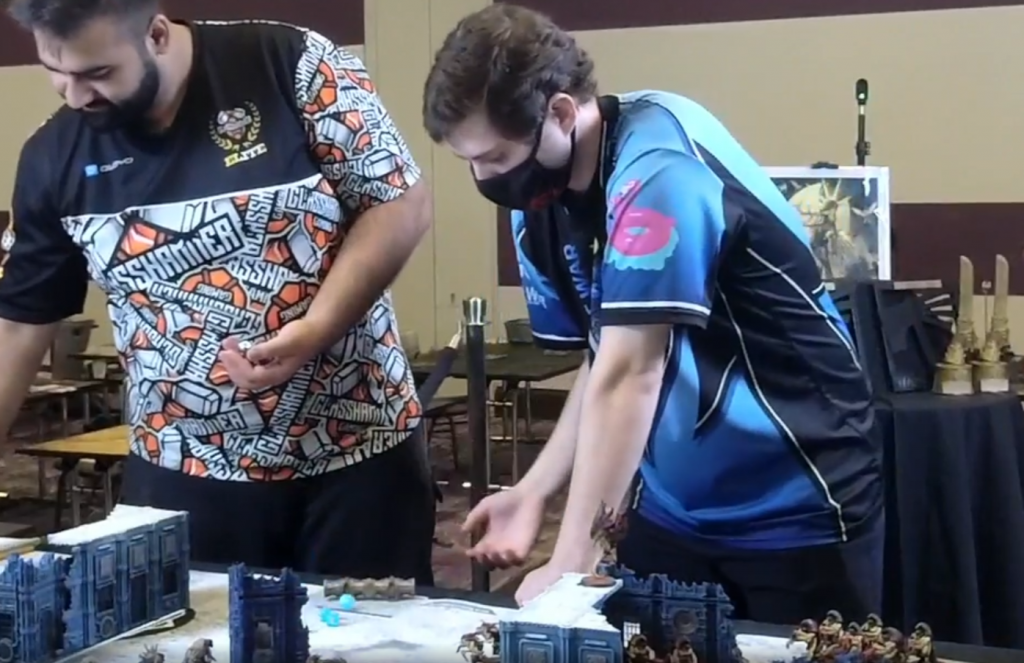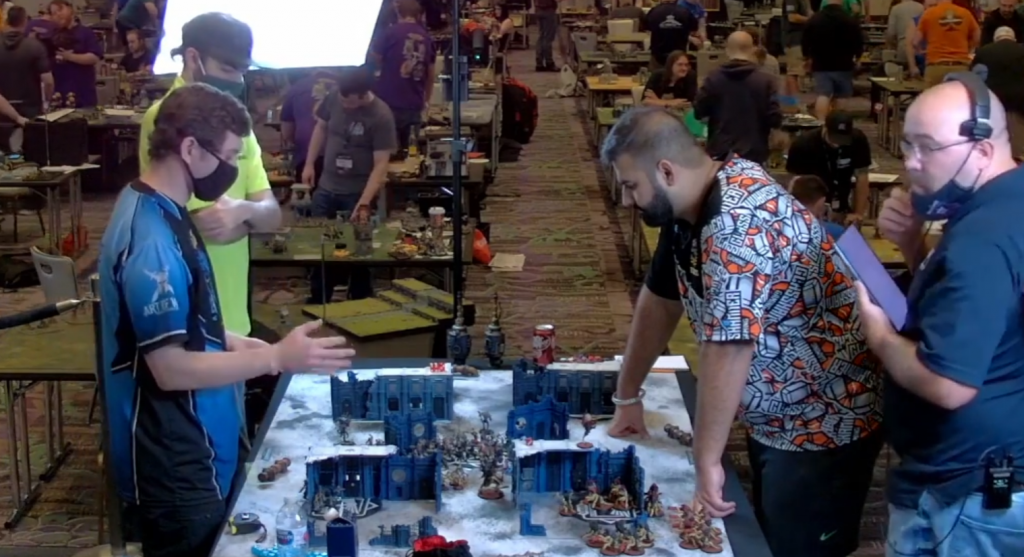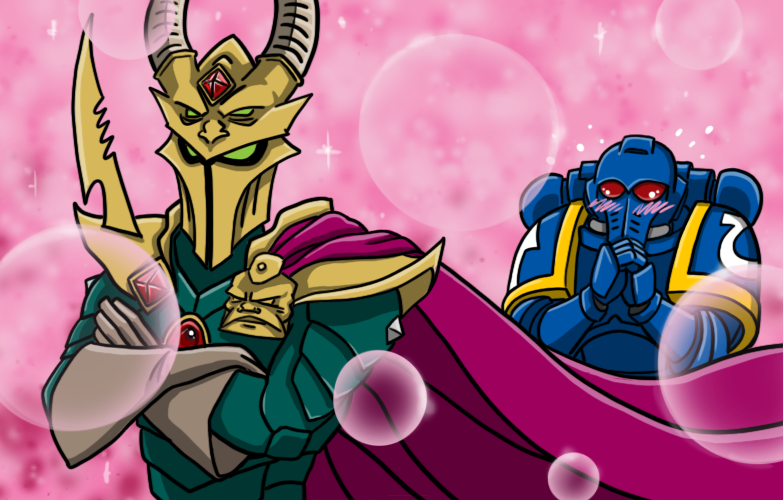For a long time, I was resistant to the idea of playing Drukhari. Since the 9th edition Codex first released in the spring of 2021, Drukhari have stood as the most powerful, competitive, and easiest-to-win-events-with faction in the game of Warhammer 40k. Just head over to 40k Stats and look at the events won by each faction in 2021 and the dominance of Drukhari is clear for all to see, or read Competitive Innovations any given week. But why did it take until November for me to switch to the best faction in the game?
I genuinely prefer playing factions that I enjoy from a lore perspective. T’au Empire, Adeptus Mechanicus, Necrons—all my favorite robots, machines, and battlesuits! So to prove my mettle I brought 8th edition T’au to the Atlantic City Open during the Drukhari’s “last hurrah” with Dark Technomancer Liquifier spam (ed: Before the first round of nerfs). I ended up beating several Drukhari players on my way to the semi-finals, including Sean Nayden, only to fall to my teammate, Nick Nanavati, in a narrow loss. I didn’t lose that game because Drukhari are broken, I lost because of mistakes that I made in that game, but I certainly did need to play perfectly to keep those games close and squeak out wins. Drukhari players on the other hand could make several mistakes – even big ones – that would otherwise be the curtain call for other factions, and still be in it with a shot to win.
Then the Adeptus Mechanicus Codex released and I was able to craft a melee-centric Veteran Cohort list that relied on threat projection and capitalizing on my opponent’s missteps to seal victory. Were Admech too strong? Yes, they were better than everything in the game bar Drukhari. But with the Balance slate update in November, the Omnissiah has fallen from grace with points increases for nearly every key Skitarii datasheet or upgrade. Was this harsh? I really believe these points increases—roughly 230-260 points—for my Veteran cohort lists were deserved. Admech are still a strong faction with great tools, but with fewer resources on that table they no longer have the safety net and extra tools they had during the summer and fall.
The problem is that Drukhari not only received fewer and less harsh points increases, but many of their key units remained unchanged andat the same time they received points decreases for other units as the cherry on top of the cake. I still cannot fathom this absurdity. With Games Workshop’s US Open Austin event on the horizon I spent several nights thinking of what I should bring. The logical choice was to bring Admech, a faction that I had won the previous two events with, and the one I had by far the most reps with in 2021. I had to trade out two units from my old lists in order to be under 2,000 points, but the core of the lists would still be the same as before. The Ork indirect and plane spam lists no longer existed, which was a major boon to the Veteran cohort style. But what about hive guard, the new indirect fire spam of choice? I knew John Lennon and likely Mani Cheema would be bringing such Tyranid lists grounded in the new Octarius Hive Fleet Leviathan rules. This matchup felt winnable, but quite difficult and I would likely have to beat both of them to win Austin.
What about style points with Necrons? They badly need points decreases as even though gaining CORE on most datasheets helped, their rules that interact with CORE frankly feel more like 8th edition rules and nowhere near as powerful as those deployed by Admech, for example. Custodes? One last ride with the golden boys before their new codex? They can beat the Tyranids indirect list, but the Drukhari matchup is difficult with how many units can crash your lines and deny primary points.
![]() I had been publicly exclaiming that Drukhari was the easiest and most powerful faction in the game and the balance update buffed the already strong – but underexplored – Coven style that was essentially a bunch of efficient statlines thrown into the opponent’s lines turn after turn. It was time to put my money where my mouth was. So, while John and Jack were away at Warzone Atlanta, Nick Nanavati summoned his Drukhari experience to give me a practice game into Tyranids so I could get a feel for the faction against another top army. Not only did I make critical mistakes in deployment, but I also mis-positioned the army during my first movement phase—something that would be a game-losing mistakes for a Tau or Admech army. It did not matter in the slightest; the durable Coven units backed by the best characters in the game simply traded too efficiently and the Tyranids ran out of units. This was true power reminiscent of old Iron Hands where mistakes simply made the game harder for you, but there was always comeback potential. And if you didn’t make mistakes? Almost impossible for the opponent to win.
I had been publicly exclaiming that Drukhari was the easiest and most powerful faction in the game and the balance update buffed the already strong – but underexplored – Coven style that was essentially a bunch of efficient statlines thrown into the opponent’s lines turn after turn. It was time to put my money where my mouth was. So, while John and Jack were away at Warzone Atlanta, Nick Nanavati summoned his Drukhari experience to give me a practice game into Tyranids so I could get a feel for the faction against another top army. Not only did I make critical mistakes in deployment, but I also mis-positioned the army during my first movement phase—something that would be a game-losing mistakes for a Tau or Admech army. It did not matter in the slightest; the durable Coven units backed by the best characters in the game simply traded too efficiently and the Tyranids ran out of units. This was true power reminiscent of old Iron Hands where mistakes simply made the game harder for you, but there was always comeback potential. And if you didn’t make mistakes? Almost impossible for the opponent to win.

I made some tweaks to the practice list by adding a larger Court of the Archon, swapping a venom for some mandrakes, and using a baseline Codex warlord trait and relic Succubus just to emphasize 80 points is still an absolute steal for such a potent character. I spent the rest of the week leading up to the event memorizing the datasheets and stratagems, while also thinking hard about matchups, particularly the Tyranid, Grey Knight, and mirror matchups. How would I deploy, what secondaries would I chose, what was my gameplan on different missions, what kinds of positional traps could I setup to force mistakes, how would I budget and spend my command points?
As is typical this year, I do not spend most of my free time playing 40k matches, instead I tend to think deeply about list choices and in-game strategy the most. Practice reps are important, but it’s almost impossible to play out every matchup, scenario and mission so that is where broad thinking is crucial to making sure you’re spending your time during a game as efficiently as possible. You should be adjusting to what your opponent is doing during a live game, rather than coming up with your strategy on the fly.

In Austin, I ended up playing a slew of excellent opponents, many of whom are highly ranked ITC players and who have accumulated many more reps with their particular factions than I had with Drukhari. The combination of my prowess with 9th edition missions and sheer state of untrammeled Drukhari power proved unbeatable—though John Lennon did come razor close to toppling it. It helped that the Admech Veteran Cohort style plays similar enough to Drukhari; the difference being that the latter has access to army-wide advance and charge, better datasheets, and some of the best stratagems in the game (1 command point fall back and charge wherever I want it? Yes, please!).
I really cannot believe how easy this army is to play and win games with. I hope the Austin event—with a wealth of other Drukhari players achieving success in the top bracket as well—demonstrates the grievous mistake made with the balance update. Drukhari are as powerful as ever and the Coven style is even easier to utilize than the previous wych cult builds. I do not how long it will take to live in a world where Drukhari are no longer an S-tier army towering above the rest of the game, but Austin I believe will be symptomatic of this larger issue. I expect Drukhari to continue to be the dominant force in competitive 40k for the foreseeable future. With Genestealer Cults and Adeptus Custodes having their new codexes delayed, that means LVO 2022 might actually end up looking more like the Atlantic City Open with a sea of Drukhari clogging the championship bracket. Whatever the playtesting process for the balance update was, the methodology was flawed and the problem hasn’t been solved and I hope Games Workshop take a serious look at bizarre dichotomy in which they dealt with Drukhari versus the Adeptus Mechanicus. Both deserved to be brought down, but only the latter was actually nerfed in an impactful way.
You can read more from Richard Siegler over on the Art of War site.
 Have any questions or feedback? Drop us a note in the comments below or email us at contact@goonhammer.com.
Have any questions or feedback? Drop us a note in the comments below or email us at contact@goonhammer.com.


